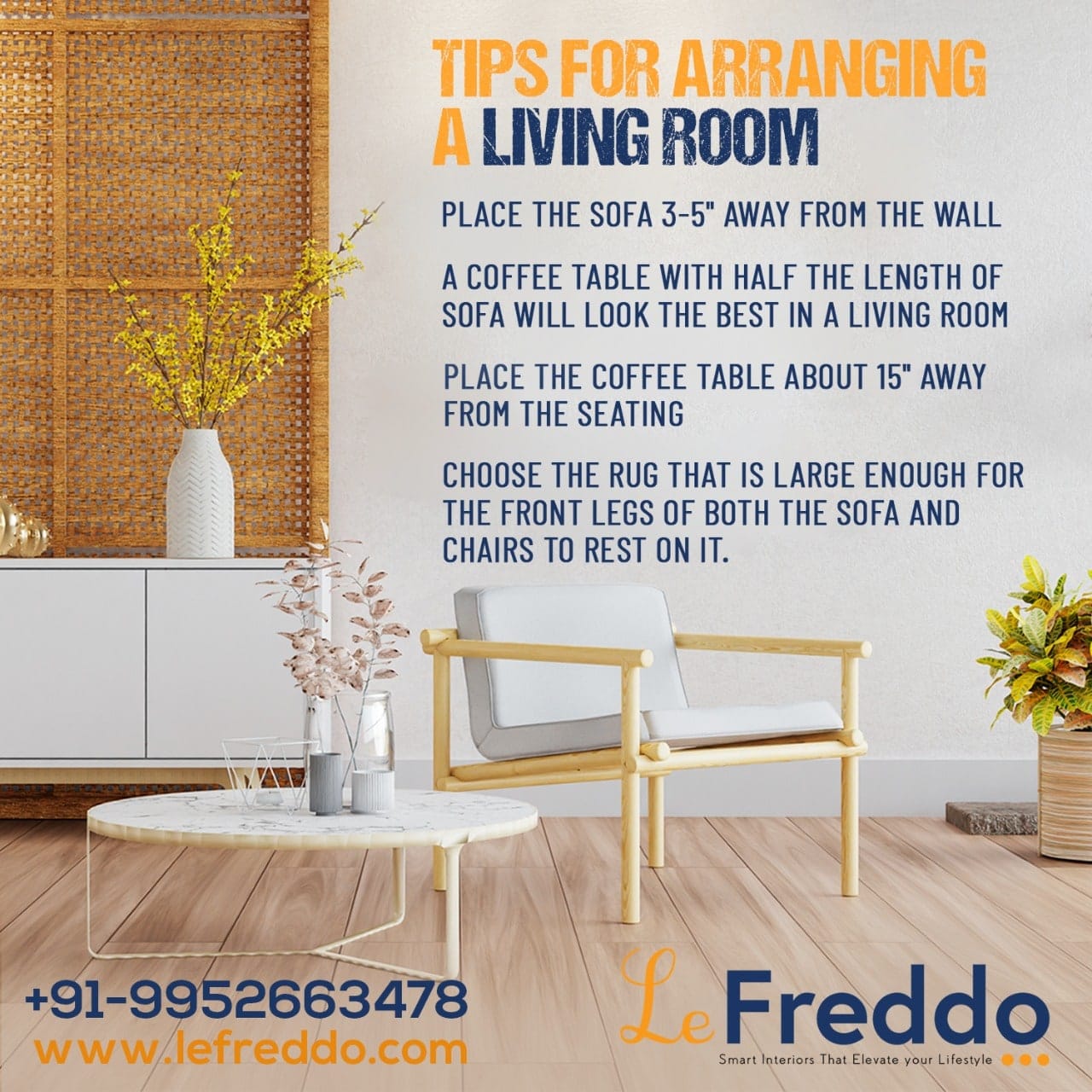
Tips for arranging a living room
Living rooms are, without a doubt, the most used rooms in the house, and they require a well-designed plan that encourages efficient traffic flow. The arrangement and spacing of furniture is critical for both comfort and functionality.
The challenge of decorating and arranging furniture in a living room might be daunting. Filling it in a way that is both functional and attractive to the eye can be a difficult undertaking. For different people, living rooms serve different purposes. The living room is a place where people, ideas, and love flow like a never-ending river. Furthermore, in order to maximize efficiency and comfort, a perfect plan of the furniture layout is required. The optimum way to arrange your sofa, chairs, accent tables, and other furniture is determined by the design of your room and its intended use. Here are a few tips from LeFreddo- the interior designers in Salem to help you arrange your living room like a pro.
Place the sofa 3-5” away from the wall
When it comes to designing the living room, the best place to begin is with the big-ticket pieces, such as the sofas and the seating that goes with them. From pick the right upholstery for your interior design to arranging them you need an experts advice. The sofa should, in general, be facing the focal point. Because sofas are so large, their placement can have a significant impact on the room’s traffic flow. People should never have to walk awkwardly around objects to get across a room. There should be no tripping dangers, either. It’s critical to leave a few feet between the coffee table and the sofa, as well as between the sofa and any chairs.
The desire to shove sofas up against the wall is a common one. Due to space constraints in some areas, this is necessary; nevertheless, in the vast majority of cases, there is enough room to move the sofa away from the wall. Give it a shot if this is the situation in your home. Around the room, you should have around 3 feet of walking space. This is what you’ll need to feel comfy and avoid running into furniture and walls. To open correctly, any sort of furniture with doors or drawers requires three feet of room. Pull your sofa away from the wall by at least 3-5 inches. Instead of generating a big lot of odd empty space in the middle, it will make the area appear more inviting and homey
A coffee table with half the length of sofa will look the best in living room
A living room without a coffee table is like to a supermodel who is without her lipstick. Coffee tables perform a variety of functions in a room, from finishing a look to providing storage and display. Which style will work best in your space is the question. However, in any high-traffic living room, furniture spacing and arrangement are crucial. Once you’ve measured twice, you’ve decorated once.
The coffee table should be between 14 and 18 inches from the sofa as a general rule of thumb. That’s close enough to reach for a magazine while still leaving plenty of room for your legs. At least aesthetically, the coffee table should be roughly 12 to 23% the size of the sofa. It’s nearly hard to measure, but when shopping for a centre table, “a little more than half the size” is a fair rule of thumb. For a 96-inch sofa, for example, you should seek for a 64-inch long coffee table.
Place the coffee table about 15” away from the seating
The first step is to think about how much space there is between the sofa and the coffee table. The coffee table should be set at a comfortable distance from the sofa, close enough to reach for a hot beverage but far enough away to allow you to extend your legs. Consider the distance from any other sitting configurations, if any exist.
Traditionally, your coffee table should be 12 to 18 inches away from your sofa; anything closer or farther than that will feel uncomfortable. You should leave at least 24 inches to 30 inches between your coffee table and your TV stand or fireplace to allow for movement throughout the room. To get the width of your perfect coffee table, subtract 42 inches from the length of your sofa and TV stand.
Choose the rug that is large enough for the front legs of both sofa and chairs to rest on it
You spend the majority of your awake hours in the living room. It’s where you unwind after a hard day, connect with your family, entertain visitors, and connect with yourself. A well-chosen area rug can bring a space together. But, most importantly, it gives your living area a cozier, more elegant, and more personal vibe. A room without a rug might appear stark, feel unfinished, and become overly noisy when sounds reverberate off the floor.
The rug should be large enough to slide under the front legs of sofas and chairs in a seating arrangement, bringing the furniture together. If your room allows, run the rug the length of the largest sofa piece and leave 30 to 36 inches of space between the larger furniture pieces. Allow at least 18 to 24 inches of space if your living room is small. That should help you make an informed selection about rug size.
To ground your conversation space, your living room rug should typically cover the size of your seating area. Furthermore, to avoid an odd look in your space, purchase a rug that is at least six to eight inches broader on both sides than your sofa piece. The rule is that the rug should only cover one-third of the width of each piece of furniture. It unifies the seating space and gives it a more cohesive appearance without the added cost of a room-sized rug.
